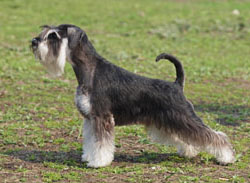Standard Schnauzers are medium-sized dogs known for their arched eyebrows and distinctive whiskers and mustache. These dogs have a double, wiry coat that comes in black or salt and pepper. The undercoat is close and soft and the outer coat is harsh. The breed's eyes are oval, dark brown, and medium in size, and the ears are set high and V-shaped. Standard Schnauzers measure 17.5 to 19.5 inches tall at the shoulder and weigh 30 to 50 pounds.
In Germany, the breed is famous for its child-protecting abilities and natural talent in the role of watchdog.
Loving and sociable, Standard Schnauzers love children and make superb family pets. They are naturally protective and make good watchdogs, but they are also strong-willed and need early and frequent training to keep negative behaviors at bay. Daily exercise is important, and these dogs are best suited to active households.
The Standard Schnauzer takes its name from the mustache and beard on its muzzle ("schnauze" in German).
Highly intelligent, lively, and fun, Standard Schnauzers make great additions to most homes. They get along well with most other pets, although they can be reserved with strangers and have a tendency to act protective and suspicious. These dogs make fun-loving companions and enjoy being actively involved in all family activities and occasions.
Standard Schnauzers are a good choice for active families with children. They are reliable and devoted and tend to be affectionate and cuddly with younger family members. In Germany, the breed is famous for its child-protecting abilities and natural talent in the role of watchdog.
These high-energy dogs need a lot of exercise in the form of long walks, jogs, and "tasks" in order to remain physically and mentally healthy. Regular activity provides an outlet for excess energy that may otherwise show itself as inappropriate chewing and digging. Because of their fearless streak and tendency to confront bigger dogs, Standard Schnauzers should always be kept on a leash or in a securely fenced yard when outdoors.
Standard Schnauzers are a relatively healthy breed, but this is no guarantee that any individual dog will be free of health problems or genetic illness. Adopting or purchasing these dogs from reputable sources is one of the easiest ways to ensure a healthy puppy.
These dogs are prone to hip dysplasia, hypothyroidism, bladder stones, and hemophilia, which is a potentially-serious bleeding disorder. Standard Schnauzers are also at increased risk for developing certain eye conditions, including retinal dysplasia and cataracts. Dermatitis and the heart condition pulmonic stenosis are seen in these dogs, too.
With routine veterinary care, regular exercise, a healthy diet, and canine vaccinations, Standard Schnauzers typically live a long and full life of 13 to 15 years.
Always a comedian, the Standard Schnauzer probably won't make it through a training session without a bit of joking around or stubborn resistance. With the right approach, though, these dogs are very trainable. They need a lot of positive reinforcement, such as praise, play, and food rewards, and they respond well to techniques that require them to work for their rewards.
Training should be firm and consistent, and it should never be overly repetitive. These dogs are very clever and learn quickly; boring or repetitive training sessions will not hold their attention and may cause them to tune out or act out. Training sessions should be kept short, interesting, and fun.
Early socialization is a very important part of caring for this breed. Puppy kindergarten is a good start, but it should be followed by trips to the dog park, walks around the neighborhood, and visits to local businesses. Socialization teaches these dogs how to distinguish between real threats and normal, everyday situations. Standard Schnauzers that are properly socialized will welcome invited guests but remain reserved and watchful around strangers.
Standard Schnauzers require regular brushing to prevent tangles and matting. They should be brushed or combed at least every few days, and more often if mats develop. Additionally, the body coat should be professionally stripped about twice each year, and shaping is needed every few months. Trimming of the beard can usually be done at home with a comb and good pair of scissors.
Bathing the Standard Schnauzer may only be necessary if the coat becomes dirtied with something sticky, stinky, or harmful. Otherwise, regular brushing will remove most loose dirt, and washing the beard and face will clean up messes made after drinking and eating. When bathing, it's important to use only a pH-balanced shampoo designed for use on dogs; human shampoos can cause irritation, dryness, and coat damage.
The nails need clipping every couple of weeks, or more often if they click against the floor while walking. Daily toothbrushing is important to keep gum disease and cavities away, and weekly ear checks help uncover wax buildup or signs of ear infection before any problems become serious. Any odor, redness, discharge, or swelling in the ears should be reported to a veterinarian right away.
Standard Schnauzers are the oldest of the schnauzer breeds and were the prototype for the Miniature and Giant breeds. They originated in Germany and date back to the 14th or 15th century. Originally kept as hunting companions and household pets, the breed likely developed from a mix of Poodle, Pinscher, and Spitz.
These lively little dogs filled many roles and were used to kill rats and other vermin and to guard livestock and property. They also excelled as watchdogs and worked to protect farmers on the road to and from the marketplace.
Standard Schnauzers made their way to the United States during the early 20th century. Today, these dogs are frequently seen in the performance and confirmation rings, and they often serve as therapy dogs or in search and rescue. They are also very popular companion animals in America.
The American Kennel Club officially recognized the Standard Schnauzer in 1904.

